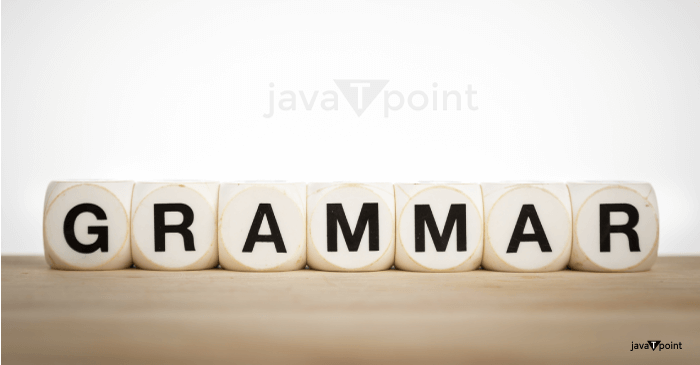Grammar DefinitionThe definition of grammar is "a body of rules governing the combination and comprehension of words, phrases, sentences, as well as other elements of a language." Syntax and grammar are the two main components of a language's or all languages' structural system. 
MeaningA language's grammar is its structural foundation. There are times when grammar tends to be referred to as a language's "rules" however, there are no rules in any language. If we say "rules," we imply that someone first created the rules before speaking the language, much like a novel game. However, this is not how languages began. Languages began with noises and later transformed into words, phrases, and sentences. No widely used language has a set structure. Every tongue evolves over time. What we call "grammar" merely expresses a language at a specific period. According to linguistics, a language's grammar is its system of structural rules limiting how speakers or authors can combine words, phrases, and clauses. The word can also be used to describe the analysis of such constraints, a subject area encompassing areas like phonetics, semantics, & practicality in addition to areas like morphology, phonetics, and syntax. The two main methods used to learn grammar are traditional grammar as well as theoretical grammar. The overwhelming majority of these restrictions are learned not by conscious study or instruction but rather by hearing other speakers. Fluent speakers of a language variety have successfully internalized these constraints. Early childhood is when a large portion of this internalization occurs; learning a language later in life typically entails more explicit instruction. According to this perspective, grammar is the cognitive knowledge that underlies a particular instance of language output. HistoryGrammar had been developed in Sanskrit as early as the 5th century BC, but what is now referred to as Traditional Grammar was created by the early Greeks, who were also the first to create an alphanumeric writing system. As a result of this development, literary works as we know them emerged, and grammar was subsequently required so that readers could comprehend and value what was written. Dionysius Thrax, a Greek, defined grammar in the first century BC as something that allows a person to speak a language or communicate about that language and how its parts relate to one another. 
Instead of the grammar being an explanation of how the language was actually being used, these Traditional Types of grammatical structures set out rules for formulating what grammarians and linguists saw as principles for the appropriate language usage. Grammars change as a result of practice. In the past, the emergence of written representations has also been accompanied by the emergence of formal rules regarding language usage. However, these rules typically describe writing norms rather than speech conventions. Formal grammar is codified usage that has been created over time through extensive recording and observation. The prescriptive idea of grammatical correctness can emerge as rules are established and refined. Due to this, there is frequently a difference between current utilization and that which has come to be understood as "correct" or "standard" over time. Although style manuals may provide helpful guidance about the employment of standard language based on descriptions of usage in recent writings of the same language, linguists typically regard prescriptive grammar as having little justification beyond their writers' aesthetic preferences. The explanation for speech variation, especially variation in an individual speaker's speech, includes linguistic prescriptions. Types of GrammarGrammar rules and languages are closely related, organically adapt to their environments, and frequently reflect the social identities of their speakers. There are basically 7 types of Grammar used in the English language: 1. Descriptive grammarThe language structure is referred to in descriptive grammar. This style of grammar is used most often by authors and speakers. The definition of descriptive grammar is "the body of rules that govern language that reflects actual usage. In descriptive grammar, there is no such thing as correct or wrong. It lacks a clear idea of how it should be constructed and instead reflects the actual speech and writing of native English speakers. It focuses on demonstrating how the English language is used rather than prescribing how it should be used. This statement does not imply a right or improper method to utilize language. 2. Prescriptive GrammarIn the same way that descriptive grammar relates to language structure, prescriptive grammar focuses on how language should be utilized. There are also excellent and wrong ways to use language in this kind of grammar. Therefore, these rules are indeed a component of the accepted grammar. The conventional view of grammar instructs users on how they should utilize the English language, including the appropriate grammatical structures and semantic purposes. Prescriptive grammar is crucial since it enables people to speak and write in formal English. Furthermore, "those who adhere to it (or those who encourage others to adhere to it) argue that doing so will aid in streamlining one's words and making one's prose more refined. In order to equip people with a common norm of usage, prescriptive grammar is taught in schools. The language structure is referred to in descriptive grammar. This style of grammar is used most often by authors and speakers. The definition of descriptive grammar is "the body of rules that govern language that reflects actual usage. In descriptive grammar, there is no such thing as correct or wrong. It lacks a clear idea of how it should be constructed and instead reflects the actual speech and writing of native English speakers. It focuses on demonstrating how the English language is used rather than prescribing how it should be used. This statement does not imply a right or improper method to utilize language. 3. Comparative GrammarThe study of comparative grammar is the branch of linguistics that compares and dissects the grammatical structures of languages. Comparative grammar is often referred to as comparative philology. 4. Generative GrammarGenerative grammar is one of the most crucial facets of linguistic theory. It is frequently described as a collection of rules detailing the grammatical structure of the native speaker's language. It covers phonological research as well as work on morphology, semantics, and syntax. 5. Mental GrammarA sort of generative grammar called mental grammar, often called competency grammar & linguistic competence, is stored in a person's brain and allows them to speak in a comprehensible way to others. Noam Chomsky, an American linguist, successfully advanced this idea in one of his works titled "Syntactic Structures." 6. Functional GrammarNoam Chomsky introduced the idea of performance grammar in the year 1960. It helps illustrate how the language is utilized in real-world contexts. Thus, it refers to both language creation and comprehension. 7. Traditional GrammarTraditional Grammar is a set of principles that specifies the language's grammatical structures and is typically taught in schools. Traditional grammar tends to be prescriptive because it emphasizes the difference between what speakers intended the language (structure) to do and what speakers are actually doing. Element of Grammar
The fundamental framework or element you must learn to talk coherently and correctly use English grammar comprises the five ideas listed below. They serve as the cornerstone upon which all other English regulations are erected. The following are the top five elements of English grammar that have to be taken care of: 1. Word OrderThe relationship between words is determined by word order in English because it is an analytical language. The subject should always appear before the verb in a simple declarative statement, followed by any objects & adverbial phrases (if any).
Changing the order of words may result in different meanings of the sentence. 2. PunctuationPunctuation in written English is used to indicate pauses, intonation, and stressed words. Commas, periods, question marks, exclamation points, hyphens, braces, colons, semicolons, dashes, brackets, an apostrophe, ellipses, and quotation marks are all examples of punctuation. Punctuation can dramatically change a sentence's meaning. Consider these examples, where different punctuations can have a different meanings:
3. Tense and other AspectsBy giving verbs specific meanings, tenses indicate whether a statement is about the present moment, past, or future. Aspect reveals whether a statement pertains to a single instantaneous activity, a regular or recurrent action, an ongoing or continuous action, or a condition. Here are some examples:
4. DeterminersDeterminers like "which," "how many," "what," and "my," among others, are required to give nouns meaning because they rarely stand-alone without antecedent context. For questions or statements to have significance, determiners must be used properly. Here are some examples:
5. ConnectorsConnectors do just what their name implies-they "connect" other phrases, words, or clauses. Among the units they link, they can convey hierarchy (if, who, that, when, because, even though), connection (but, and, yet, nor), along with the correlation (either, or, both, and). Here are some examples of connectors:
Next TopicLand Definition
|
 For Videos Join Our Youtube Channel: Join Now
For Videos Join Our Youtube Channel: Join Now
Feedback
- Send your Feedback to [email protected]
Help Others, Please Share










